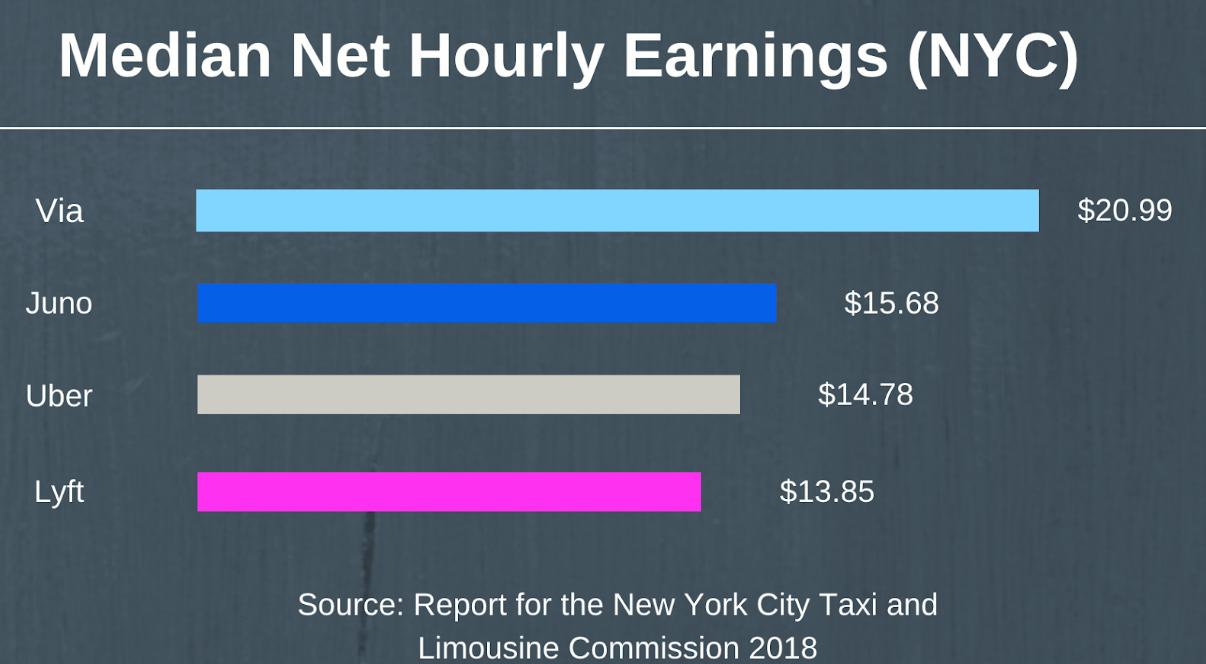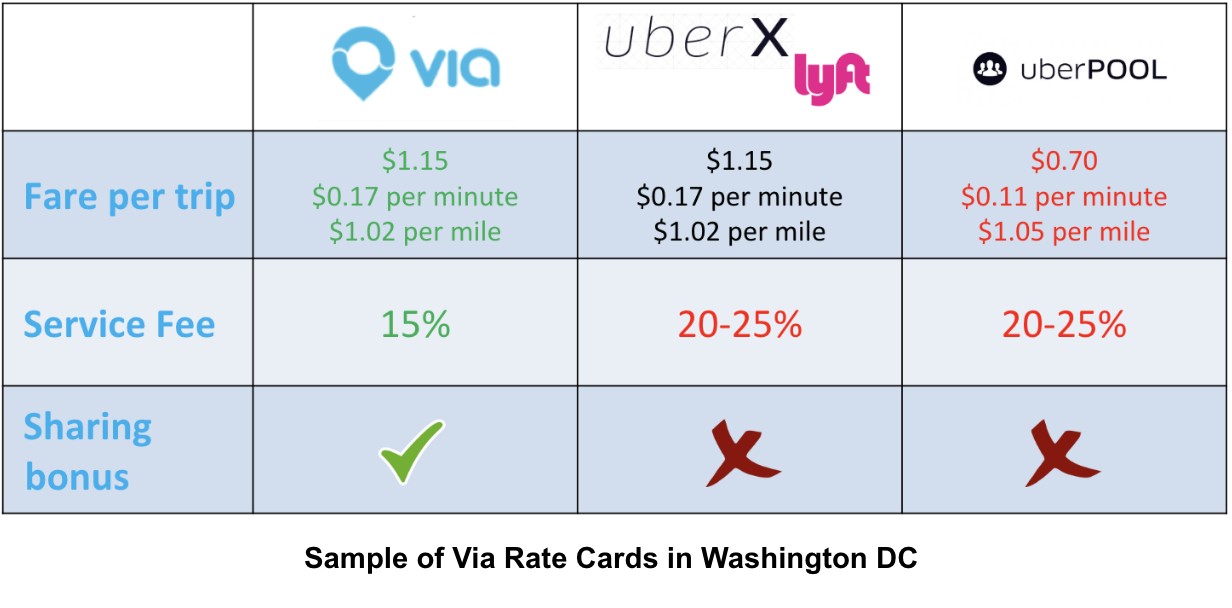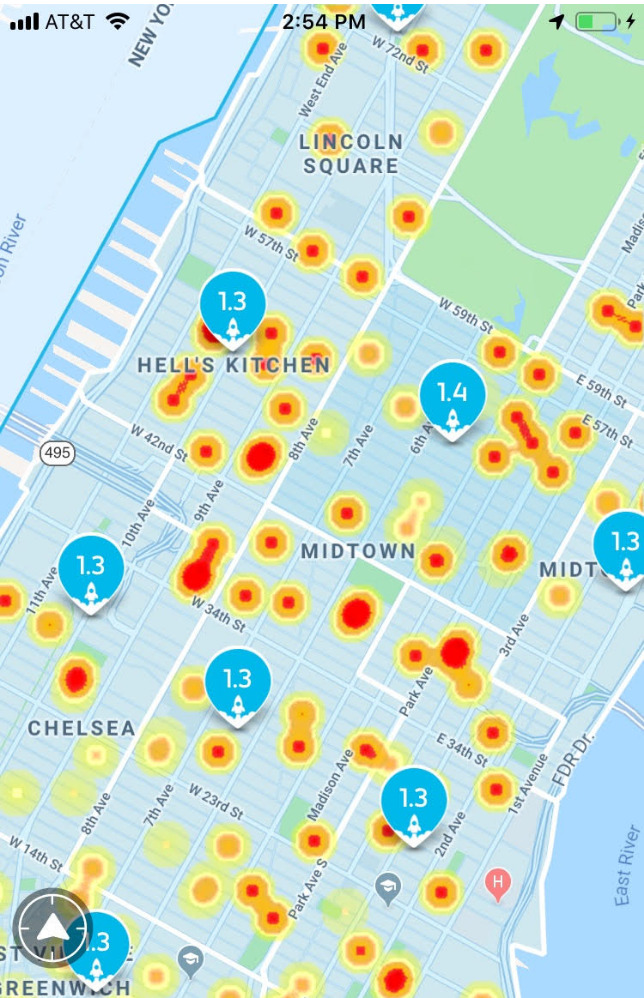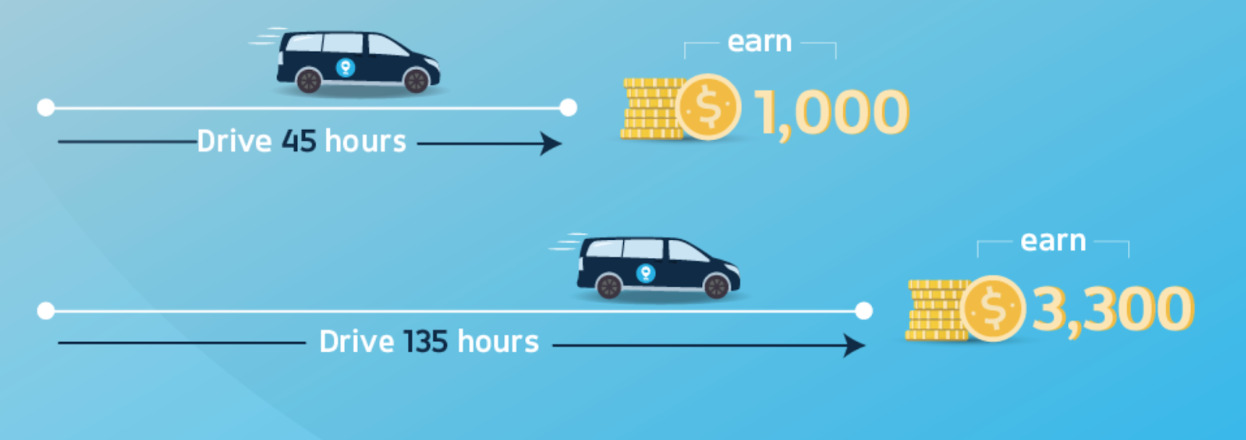
A Via driver will make more money and drive less. Learn more about Via, a new ridesharing service similar to UberPool and Lyft Line, but better.
Chonce Maddox Rhea
17 min readAt no extra cost to you, some or all of the products featured below are from partners who may compensate us for your click. It's how we make money. This does not influence our recommendations or editorial integrity, but it does help us keep the site running.
Via is a rather unique rideshare company when compared to the Big Two. Via drivers get paid to shuttle multiple passengers who are headed in a similar direction, only stopping to pick-up and drop-off on a corner to corner basis. Passengers then walk the last block or two to their destination to avoid unnecessary detours while making the rides more efficient. Most rides are shared rides on Via.
A lot of former Uber drivers are finding they enjoy Via’s model for a few good reasons. For starters, Via allows many drivers to choose between hourly pay (aka Blue Mode) and per-trip pay (known as Online or Flex Mode). Drivers are also rewarded for doing shared rides instead of being punished with a lower rate of pay like on UberPOOL. On top of all of this, Via charges a much lower (and fixed) commission rate. All of these things contribute to something important:

Rideshare companies in New York City are required by law to share their trip data with the Taxi and Limousine Commission. This means that NYC is one of the very few places in the United States where we can get reliable, third-party data from regulators on the pay of rideshare drivers.
Want To Become A Via Driver? Start Here
The TLC data published in July of 2018 showed that Via drivers earned a median of $20.99 in net earnings (after expenses) per hour. Meanwhile, Uber drivers earned a median of $14.17 per hour. That means an Uber driver in NYC could potentially increase their pay by 48.14% by driving for Via.
Via drivers also operate in high-density urban zones. That means Via drivers tend to put fewer miles on their vehicles since there are no long distance trips outside of their tighter operating zone. Additionally, pickup locations are mapped in advance so drivers can wait safely, not blocking traffic or requiring riders to step into traffic. All of these things add up to make a big difference in reducing wear and tear and depreciation.
In This Article
NYC Via drivers tend to appreciate the fact that passengers can meet at a very convenient street corner to get picked up. This helps make the driving process more efficient, especially in busy areas like Manhattan and Queens.
In the past Via has offered promotions to drivers who lease a Mercedes Metris for 30 days. Naturally, minivan drivers can earn more with Via since they can transport more passengers at the same time.
Via offers NYC drivers a guaranteed hourly rate with Blue Mode (explained below). Some NYC drivers like the guarantee that Blue Mode provides while others prefer Flex Mode which allows them to accept rides anywhere and earn per each passenger. Getting into Blue Mode directs you to drive to a terminal which would be several miles from your starting location.
If you can pick up passengers as soon as you turn on the app, it may make sense to try out Flex Mode to save some gas/time as well.
In Washington D.C., you can drive for Via any time you want since the service is available to passengers 24 hours per day and 7 days per week. Expect to frequent stops to pick up passengers across Arlington County, Alexandria, VA along with to and from the Dulles and Reagan National airports.
Via came to Chicago in late 2015 and also has guaranteed rates in the city which tend to range from $12 per hour to $30 per hour. Higher hourly rates depend on peak times like when people are heading in to work in the morning for example.
In August of this year, Via expanded to include the entire city of Chicago plus nearby towns like Evanston, Norridge, and Harwood Heights. Via drivers can now transport passengers to transit stops as well which includes 65 Metra and CTA stations.
This new expansion should help Chicago drivers gain more pool passengers since some have stated that pool rides are actually not as common even though that’s a highlight of the platform. Still, a wider coverage area could also make pool rides longer causing you to spend more gas. Also, picking up passengers on street corners of busy city blocks can be challenging if you wind up on the wrong side of the road so it’s important to learn your area as much and get comfortable with using Via’s map system.
About two years ago Arlington traded in their public commuter bus service for pool ridesharing through Via. Customers only pay $3 per ride or $10 for a weekly pass and the fees are subsidized by the city.
Via drivers in Arlington go everywhere from the downtown area and entertainment district to the Parks Mall, Centreport, and the TRE Station. Like Chicago, Via’s Arlington service area is expanding which means more opportunity for drivers.
Seattle is another city that has adopted Via as a form of public transit for the community. Via drivers operate shuttles to transport riders to and from Metro buses along with the link light rail. In addition, still operates as a normal pool ride with specific stops per each rider’s request..
Via is not operating in New Jersey yet but they have been steadily expanding to new areas over the past two years. If you are interested in trying out Via as a driver your best bet may be to go into the NYC area if possible.
In order to become a driver with Via, you must have a valid driver’s license and have at least one year of driving experience. Drivers must also pass a criminal background check.
If you’re in NYC, you’ll have to get a TLC license if you don’t already have one. Chicago drivers must pass a vehicle inspection each year.
You can use your own car with Via so long as you have a 2019 or newer non-luxury vehicle or a 2005 or newer luxury vehicle. If you don’t have a car, you can still drive for Via in some cities where they have partnered with other companies to offer you a short-term rental.
You must be over the age of 21 and have at least one year of driving experience in the United States in order to qualify to drive with Via.
How much you can earn driving with Via depends on quite a few factors including whether you’re earning a guaranteed hourly rate, the time of day that you’re driving, and how many pool passengers you pick up. For example, some drivers in Chicago have admitted to earning $2,000 per week (after working long 80-hour weeks), while others say they earn an average of $100 per day during week days in the same area. If you’re not doing Via full time, you could be earning much less.
If you opt to receive the hourly rate that comes with Blue Mode, you’ll be notified of that amount the night before you drive. The rates will be delivered via text or as a notification through the driver app.
Drivers get paid on Mondays and you’ll also receive your weekly report. This report includes all the details for your fares, promotions, reimbursements, etc. Every Tuesday, your weekly earnings are deposited into your bank account.
Via drivers can choose to earn in different ways. Drivers can earn guaranteed hourly rates or by-the-trip. Guaranteed hourly rates, known as Blue Mode, are available for all drivers in NYC and Chicago and for selected drivers in other cities.
In Blue Mode, drivers earn at a guaranteed hourly rate and pickup and dropoff as many passengers as Via assigns. When you drop-off your last passenger, Via will direct you to a “Terminal” to wait for your next dispatch. You can take breaks in Blue Mode between rides by “pausing” the app.
The hourly rates are posted pre-commission. For example, a “$20-hour” will net a driver $18 after say, a 10% service fee.
Drivers in “Blue Mode” receive more stable hourly earnings, but they don’t collect Via’s version of Dynamic Pricing (called Rocket Pay). They get paid the same regardless of how many rides they give in Blue Mode, whether that’s giving a lot of rides or none at all. It’s perfect for those who want stable pay during commute hours.
Hourly rates in Blue Mode will also change throughout the day according to peak demand. The rates are viewable in advance within the Via app. Blue Mode hours are not available 24/7 for drivers in each market but tend to be fairly consistent while mirroring the busiest times of the day. If there are no Blue Mode hours available, the driver app will switch over to Flex Mode.
Via is testing promotions in Blue Mode that will offer a cash reward for completing a certain number of hours in a given day. It’s similar to what Uber calls “Quest” and these earnings are in addition to the hourly earnings in Flex Mode. It’s kind of like getting a bonus for doing more rides.
New York City: Blue Mode is available to all drivers in NYC. Drivers can toggle between Blue Mode and Flex Mode based on their preferences.
Chicago: Via offers a Welcome Promotion for every new driver to join in Blue Mode if they want. They can opt-out, and drive in Flex if preferred.
Washington DC: Blue Mode is presently offered to a subset of drivers that have a history of good performance and quality driving. Once a driver opts-in to Blue Mode, they can opt out at any time.
For those driving in DC and Chicago, you can switch to Blue Mode and back to Flex once. If you want to be a Blue Mode driver, we recommend reaching out to one of Via’s local driver centers. However, drivers outside of NYC cannot toggle between Blue and Flex Modes.
Drivers in Flex Mode get paid for every trip they complete. They earn money based on a published rate card that pays similar to UberX or Lyft Classic (so with Via there are no reduced rates for shared rides). In fact, drivers on Flex Mode are incentivized to accept more passengers on each ride since each passenger triggers a small increase in the multiplier for the entire ride.
So think of getting paid the same for an UberPOOL, but then getting a 1.1X or 1.2X multiplier for picking up additional passengers along the way. It’s a far more compelling pay model for drivers than UberPOOL or ExpressPOOL.

There are a lot of factors that go into the dispatch algorithm, but the algorithm seems to assign a higher “weight” to those in Blue Mode. This is important to consider if you choose to opt for Flex Mode because it may be tempting to go from Blue Mode to Flex Mode with the belief that you will be just as busy on Flex Mode.

Rocket Pay is Via’s version of dynamic pricing and is available to drivers using the Flex Mode pay scheme. This acts as a pay multiplier on the entire fare for areas that experience more demand by riders than can be fulfilled by drivers. So a $10 fare that got 1.5x rocket pay would become a $15 fare. Rocket Pay with via has the following features;
Rocket Pay is similar in many respects to Uber’s older version of surge that most old-school drivers prefer since it’s easier to predict and leads to less “chasing the surge”.
That being said, Via “surges” with Rocket Pay occur less often than Lyft Prime Time or Uber Surge. So don’t expect it to always be around. Especially at 2 a.m.!
For Flex Mode drivers, Via will add a sharing premium for each additional passenger ranging between 5% and 20% depending on what city you drive in and how many additional riders you get.
I think this is compelling because it actually provides a financial incentive for drivers to do shared rides. When Uber is paying less per mile and requiring more work, Via is actually paying more to reflect the extra work of the ride.
Via’s original business model is based on providing shared rides. The service is corner-to-corner (versus door-to-door with POOL on Uber). Via also only dispatches drivers to pickup and drop-off in legal, safe locations, resulting in far less time spent trying to locate your passengers since Via passengers will already be in these designated places.
Like other rideshare companies, Via offers bonuses to new drivers in some cities.
In NYC, Via offer a $1,000 bonus that can be earned during your first 4 weeks. Via also offers late-night driver promos as well.
In Chicago, Via guarantees that drivers will earn $3,300 during their first 45 days after driving 135 hours. There’s a guarantee of $1,000 in earnings if you drive for 45 hours.

Every hour in Blue and Flash Blue mode counts toward your promo and 3 Flex rides count as 1 hour.
Via’s promos vary by city and may change from month-to-month so be sure to check for a deadline or expiration date (if it applies) in the fine print.
Via takes far less of each fare than Uber or Lyft. In Chicago and Washington DC, Via only charges a 15% service fee on each fare. In New York City they only charge 10% for Blue Mode and 20% for Flex. Both are MUCH lower than the commission rates charged by Uber and Lyft.
In comparison, Uber and Lyft charge most drivers a minimum commission of 25% but their REAL commission often comes out to anywhere between 27% and 55% after you factor in things like Upfront Pricing, New Surge, and Service Fees. So only charging 10% – 15% is big a deal.
Consider this, a driver giving $50,000 in gross fares over a year would save $5000 on Via’s lower commission structure. Or you could drive 3-5 fewer weeks each year and make the same as before.
Want To Become A Via Driver? Start Here
One of our favorite parts about Via is that they have a live support team that is availavle for chat, email, or phone support whenever there is a problem on the road. You will get a live person who works for Via in real-time. They’ve had this around since day 1 when they launched 5 years ago, much longer than Uber.
Since Via operates as a shared-ride service, it is busiest during commute hours, so the passengers tend to be of a regular (non-drunk) variety that are simply trying to get to and from their jobs without incident. Most of the passengers use the service often, which means that you end up with a lot of repeat passengers that you can build a great relationship with, too.
Via also does a great job educating passengers about the shared ride experience, so you get passengers who know how everything operates. Or in other words, they are far less likely to ask you to wait or to drop them off in another location than they requested, or to show up with more people than were originally booked. In fact, if the passenger is not ready then you are expected to leave.
Via definitely has its pros and cons. But as regular RSG readers know, we like to hear feedback straight from the drivers. We talked to Cameron, a Via driver out of NYC, and here’s what he had to say.
“I started working with Via since 2017. I worked with them part-time for a year. The way they function is to pay you an hourly rate based upon demand and it works like a mini bus service.
I wanted to diversify my rideshare opportunities and they were offering bonus money for sign up. I liked how even if it was not busy in NYC, I would still be earning an hourly rate.
I worked in NYC primarily and that is the only place I could with my TLC Licensing. Manhattan and Brooklyn had rides during the time frames I worked but now they have expanded to all boroughs.
The issue with Via is that it is capped for how much you can make per day because they pay an hourly rate. It may have stability but none of the upside. To compare it to being a stockbroker, Via was like trading Bonds vs trading Stocks. It was guaranteed income but it never had the excitement I would get from seeing my screen flash with a BLACKSUV 45+ min as I did with Uber, Lyft and Juno.”
After reading through driver’s feedback on rideshare forums, it also seems that people have a love/hate relationship with earning a guaranteed hourly rate. On one end, it provides some stability but it’s also no secret that many drivers prefer to work as true independent contractors and earn as little or as much as they want depending on where and how often they drive.
You can sign up for Via by clicking here.
I have always said drivers should diversify the platforms they drive for. Via is a new earnings platforms for drivers that is worth checking out. Once you are signed up, you can also take advantage of their driver referral bonuses as they grow – and they plan to grow.
Since they are still relatively new/young this gives early adopter drivers a really good opportunity to make some serious referral income on top of their standard pay model. Via currently operates in New York, Chicago, and DC, as well as in partnership with the cities of Arlington, TX, and West Sacramento, CA and its joint venture, ViaVan, operates services in Amsterdam, London, and Berlin.
Driving for Via will generally require commercial auto insurance for rideshare drivers. We highly recommend this for Uber and Lyft drivers too because it protects your earnings and liability.
Overall, expect to earn in the $15-$20 per hour range, with earnings above $20 per hour during peak times. Earnings for NYC, and SUV drivers, can be higher. Full time drivers can definitely earn over $1000 a week driving for Via.
Uber takes the most money out of the ride fare, compared to Via, but it also charges the most on average. This still means you might be making less than you would with Via if you don’t pick up enough pool passengers.
All Via drivers must meet the following requirements: Be at least 21 years old, have a valid driver’s license, at least one year of U.S. driving experience, pass a criminal background check.
Vis does require driver applicants to pass a criminal background check before getting accepted on the platform.
In NYC the minimum hourly rate for rideshare drivers is $17.22 but Via insists that their drivers tend to make more than that. Via drivers spend less time cruising in-between rides than Uber and Lyft drivers. Via drivers can expect to earn $21 per hour on average.
Readers, have you ever heard of Via? What do you think of the UberPOOL/Lyft Line model that actually pays you more to take on multiple riders? Do you think this would save you gas costs and time?
You Might Also Like Related ArticlesWe're 200,000 drivers strong – join us!